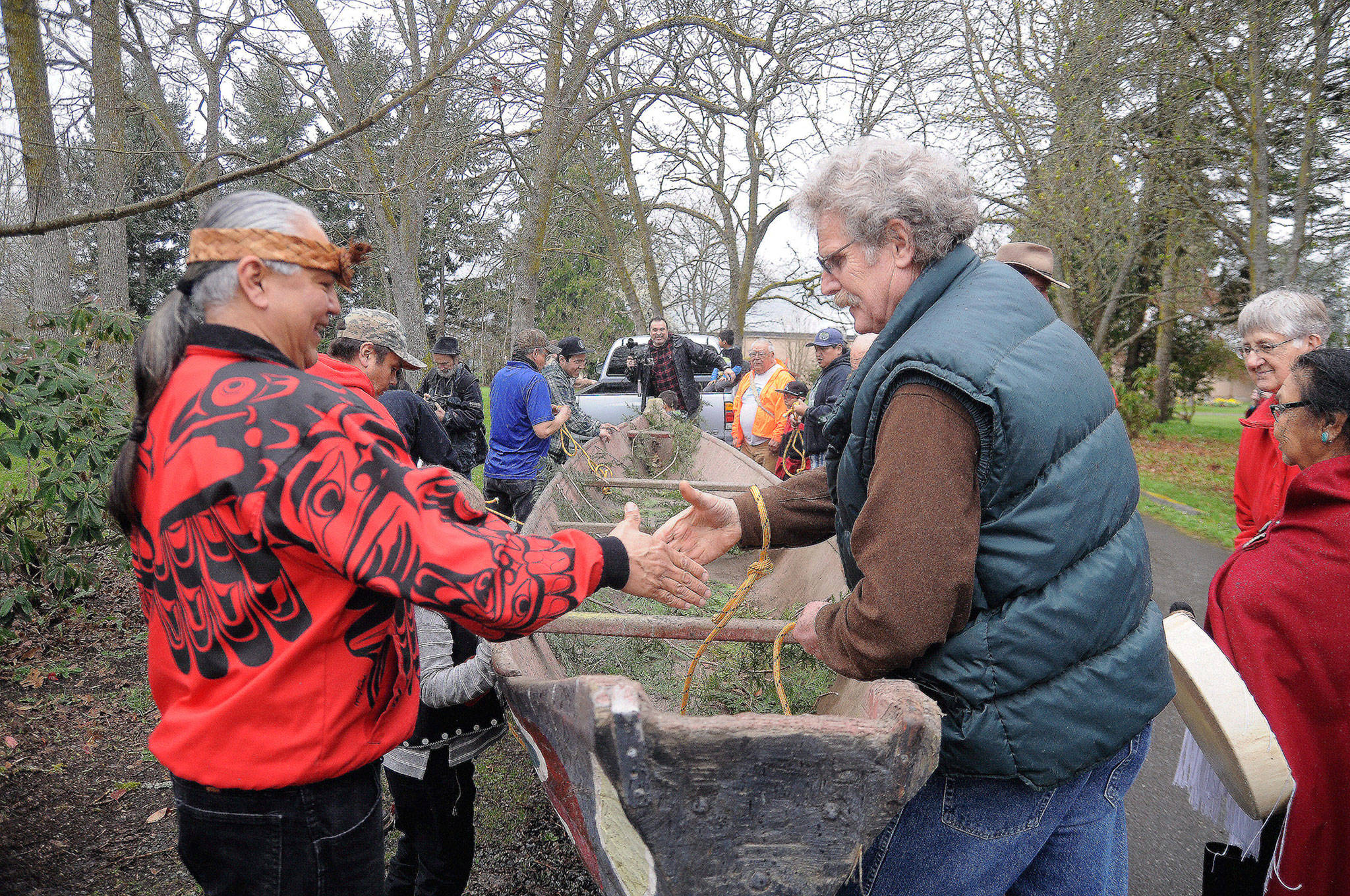“This is a day I never thought would come.”
Surrounded by friends and family, Viola Penn Riebe of the Hoh Tribe gave heartfelt thanks Saturday for a community effort that helps restore a piece of her family history.
“This canoe … has been hiding in plain sight all these years,” Kurt Grinnell, Jamestown S’Klallam tribal council member, remarked to a packed Pioneer Memorial Park clubhouse, as tribal members and others gathered to bless the removal of a large, hand-carved canoe from the park grounds.
The canoe, made by Riebe’s uncle William E. Penn in the early 1960s, is moving closer to the family’s native ground and will be housed at the Olympic Natural Resources Center in Forks.
“That’s the canoe that sat in our yard, (that) he finished carving,” Riebe recalled. “This canoe we’re moving today is an honored guest.”
How the canoe came to find its temporary home at the park, home to Sequim’s first cemetery that’s now owned by the City of Sequim and maintained by the Sequim Prairie Garden Club, is a mystery that garden club member Priscilla Hudson helped unravel.
Hudson had written a grant about two years ago to install new shake roof shingles that were protecting a canoe which had been at the park for years. In her research, Hudson found that Cy Frick had donated the boat to be showcased at the park in the 1960s.
In researching other aspects of the park for visitor tours, Hudson and other garden club members struggled to find the story behind the canoe.
There was interest in restoring the canoe, but someone had added artwork to it — “I have no idea who painted it,” Hudson said — and so Hudson went about trying to find the original owner/maker.
“I didn’t want to restore it until I figured out who painted it,” she said.
“I went to (several) tribal meetings — no one knew.”
In October 2016 Hudson found a link to the canoe at the Jamestown S’Klallam Tribe’s carving shed, where a story had been passed about a family looking to borrow the canoe for a family reunion, Hudson said. That story led her to Dixie Laudner, a payroll administrator for the Jamestown S’Klallam Tribe … and Viola Riebe’s daughter.
Soon Hudson was face-to-face with Riebe, a cultural resources specialist and elder with the Hoh Tribe.
“We both started crying,” Hudson said. “It was wonderful. It caught my heart. I was so blessed to find that family … and more importantly, that it can go back to the family.”
Family roots
Riebe said Penn, the canoe’s carver, was particularly special to her after Penn came to live with her family.
“He was my hero,” she said.
She recalled numerous times visiting the canoe at the Sequim park.
“I knew that was my canoe,” she said. “I prayed. I determined that whatever will be, will be. I left it. (I thought), ‘I’m not going to fret about that anymore.’”
“Fifty years later, I got the call.”
On April 8, Hoh, Quileute and Jamestown S’Klallam tribe members gave blessings not only to the canoe — named “The Viola” — and its journey, but also to the event as a whole.
Riebe said there will be an even bigger ceremony in Forks after the canoe is restored.
“(We) talked about where it could be used for educational purposes,” Riebe said, so the family worked with Frank Hanson, education and outreach coordinator at the University of Washington’s Olympic Natural Resources Center in Forks, and decided to gift the canoe to the center.
“(This canoe) is a treasure, so much history behind it,” Grinnell said. “It’s time to go back home.”
Following a meal, a review of the canoe’s history and several songs and blessings, the crowd of about 100 strong at Pioneer Memorial Park witnessed songs and a blessing from Riebe’s nephew Vince Penn, of the Quileute Tribe, followed by cedar bough blessings and, thanks to some strong arms, removal of the canoe for its journey westward.
“It’s a very good day,” Penn said. “This is not the end. It’s a beginning.”



